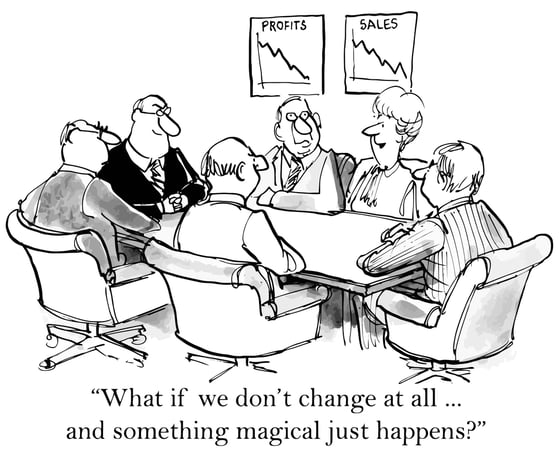
As a business owner, I’ve gone through a bit of an emotional roller coaster over the past couple of months as this whole COVID-19 pandemic has and continues to play out.
First there was denial – how serious could this really be? Followed by disbelief, empathy and like many other people, a healthy dose of fear - about the impact to our economy, and ultimately businesses across the world, mine included.
But one of the things you’re forced to learn as a business leader is that you must be resilient to survive. You need to adapt when the world throws you a curve ball – whether it’s a key employee being poached, a cash crunch, or, ahem, a global pandemic.
We’re in uncharted territory here, and everyone has opinions as to what businesses should or shouldn’t be doing in a time of crisis – from the stockpiling of much-needed supplies to accepting government bailouts.
For the foreseeable future, this is our new normal and it’s not going away anytime soon. The businesses that adapt and reframe the situation as an opportunity are going to do a lot better than the ones who sit on the sidelines because ‘no one in our industry is doing that right now.’
That said, my heart goes out to businesses in retail, food services, travel and other industries that are crippled by mandatory closures and other sweeping but necessary mandates.
But in many industries, especially B2B, it's very possible to do what needs to be done to survive (and maybe even thrive a little) without exploiting the situation in an opportunistic way.
First, let’s highlight some of the bigger challenges businesses of all sizes are facing right now.
Challenges to businesses in the wake of COVID-19
So what are some of the key challenges businesses are facing during this crisis?
- Lost revenue, delayed contracts, uncertainty
- Cancellation of trade shows and industry events – big lead and revenue drivers
- No in-person sales calls, face-to-face meetings, or presentations with prospects
- Learning curve for managing a remote workforce
- Keeping employees busy, engaged, and fostering collaboration
- Not set up for success in a digital world – antiquated tech, processes, etc.
- Getting ROI out of virtual events
- Ripple effects in supply chain disruptions
The list goes on. And add to that an unprecedented level of uncertainty as to what lies ahead.
Should you take action or ride out the storm?
Borrowing from business author Steven Covey’s Circle of Control philosophy, sometimes there are external forces that are out of our hands and there’s not much we can do about them - yet we spend all our time and energy being helplessly concerned with them.
The proactive, however, relentlessly focus their efforts on the things they can control.
In his words: “I am not a product of my circumstances. I am a product of my decisions.” - Dr. Stephen R. Covey
Are you going to ride out the storm like many of your uninitiated competitors, or will you take advantage of the extra time, resources, and capacity you may now have on your hands?
The decision is yours.
11 things businesses can do right now to come out of this crisis stronger
Many of my suggestions below are focused on sales and marketing. Yes, I am a marketer, telling you to spend more time on marketing while your hair is on fire.
But isn’t that what marketing is all about?
- Assessing the current state of affairs.
- Finding a competitive edge.
- Leveraging it to your advantage.
The fact is, between adapting to your new reality and the pile of back-burner projects that you’ve been meaning to get to for years, there’s likely plenty of work to be done - sales, marketing or otherwise.
Maybe it’s time to flip the script, build up some competitive advantages, and create your own destiny.
Here are some ideas to get started.
Revisit your sales and marketing game plan
Your current marketing strategy is probably going to need a lot of revamping and must be adapted to the new business normal.

Many of the marketing channels you have may have relied on historically have vanished. Outside sales teams are severely challenged in a shelter-in-place environment and face-to-face meetings will become increasingly difficult to come by.
It’s definitely not ‘business as usual,’ so the same old strategy won’t work. You need to get creative and maybe even a little out of your comfort zone to navigate these unprecedented challenges.
But first you’ll need to ask yourself some basic questions:
- How will you reach new customers now and where do they spend time online?
- How will your customers make buying decisions now?
- What KPIs will you be tracking - will they change?
- What are the ideal sales and marketing channels and their associated ad spend?
- Will you need to adjust your lead and sales forecasts?
- Will you be able to recoup and reallocate budget for cancelled events?
- Can your planned campaigns and initiatives be adapted to a remote environment?
It might help to deconstruct your existing plan, breaking it down to its individual components, and then piecing the still-viable parts back together. You’ll likely find some gaps that can be filled with some of the other suggestions below.
And remember - there’s still a lot of uncertainty as to what lies ahead. When you create your new road map, keep it agile, modular, and flexible so you can adapt to any unanticipated hurdles.
Audit, adapt and rebuild your sales and marketing plan to run lean, stay visible and find new customers in a work-from-home environment.
Schedule a meeting to learn how →
Refine outdated brand messaging
 Many companies haven’t revisited their brand messaging, things like unique value proposition and competitive differentiators, in years.
Many companies haven’t revisited their brand messaging, things like unique value proposition and competitive differentiators, in years.
Riding on your reputation coattails isn’t as easy without face-to-face relationship building with your prospects - no more fancy dinners, golf trips, or weekend getaways to Aspen (we’re talking to you pharma reps).
You’ll need data-driven research, customer insight and a holistic understanding of your ideal customer’s pain points and buying behaviors to craft messaging that will drive them to action.
Consider rounding up a few of your customers and asking them questions like:
- What happened/changed that caused you to start looking for a solution like ours?
- What steps do you take to find a vendor and decide to use them?
- What specific aspects/capabilities of a vendor’s product, service, company or process do you consider when choosing a firm like ours?
- What outcomes do you expect to receive when purchasing a solution like the one we offer?
- What prevents you from doing business with a company like ours?
You’ll have meaningful, actionable information you can mine. Look for patterns and commonalities in your responses and use these insights to inform your go-to-market value proposition and competitive advantage.
Reallocate marketing spend and rethink advertising channels
As most (if not all) trade shows, conferences, seminars, networking and other live events have been cancelled, businesses relying on these channels are left scrambling to figure out how they will reach new prospects.
With election-year political advertising driving up the cost of traditional media like radio and TV, and with a stuck-at-home-and-always-online audience (mobile usage is up 40%), leveraging digital is almost a no-brainer.
Companies in old-school industries will have a real competitive advantage by embracing the new normal while their competitors wait for things to go back to the status quo.
In more saturated verticals, lean, strategically-crafted campaigns will win out over a one-size-fits-all or shotgun approach. So rather than blogging aimlessly or posting on social media just because, you need to take a much more coordinated approach.
Make sure to:
- Understand exactly why and how your customers make buying decisions, what their success factors are, and where they go for information.
- Craft the messaging that precisely hits on their pain, addresses objection and removes friction in the sales processes.
- Find out all the channels they use online and be there consistently, with the right message for the right role.
- Consider partnering with prominent industry associations or trade publications to leverage their reputation and reach.
- Educate and offer something of value (hint: content).
Even if buying decisions aren’t being made today in your industry, they will be as soon as all this clears up. Why not have a few solid deals in the pipeline?
Shift lead- and opportunity-generation tactics to the web
If your go-to strategy has been coughing up $30K for a trade show booth and handing out swag for lead gen, it’s time to adapt.

You’ll need to learn how to find, target and engage these people online and get them to virtually hand over that business card.
Remember all that great content you created? This is how you put it to work.
Prospects will gladly hand over their contact information for high-value content. So offer up those case studies, white papers, sales presentations, webinars, and giveaways on your website and start replacing that lost trade show pipeline.
Use landing pages, calls-to-action, subscription modules, and premium gated content to capture contact info right into your CRM.
Build an arsenal of content as a competitive advantage
As more work shifts online, using content as a sales, marketing, branding, and communication tool becomes exceedingly important for any business.
And whether it’s in a filing cabinet, on an intranet or in people’s heads - odds are you have a virtual treasure trove of information ready to be actualized into great content. If you find people on your team with extra time on their hands, use it as an opportunity for a cross-functional effort to build out a content library.
Ideas could include:
- Research compilation and publication
- Thought leadership and industry insights
- Case studies, white papers, and downloadable assets
- Industry- or solution-focused website pages
- Customer service and support articles
- How-to videos and product demos
- Educational blog content for early-journey buyers
- Curated content for social platforms and email campaigns
There’s a ton of data out there that suggest companies who create good content get more brand equity, leads and sales; and although most organizations understand the value in creating it, they struggle with prioritizing it.
So put your team to work.
Build out a 2020 sales and marketing strategy that is agile, targeted, and effective despite the challenges in the current business environment.
Schedule a meeting to learn how →
Overhaul your website - it probably needs it
It’s likely that over the years you have evolved as an organization but your website has not evolved with you. If you’re like most companies, a website redesign has been on the project backlog for a while but you haven’t had the time, attention, or internal resources to make it happen.
 Well, now you may.
Well, now you may.
Your prospects and customers will be online a lot more in 2020, eager to consume content, and your website will be one of their primary interaction points. It’s more important than ever that your message, capabilities and accomplishments are up to date and professionally communicated.
- Is your website up to par for the industry and your competition?
- Are there multiple lead-generation pathways on the site?
- Does it educate and answer questions in a clear and concise way?
- Do you show ‘proof’ that you can do what you say you do (testimonials, case studies, statistics)?
It’s 2020. Your website should be one of the most effective sales and marketing tools in your arsenal - and it works on your behalf 24/7.
Evolve, adapt and adopt your systems and processes
“All our business comes from networking and word of mouth.”
“It takes a handshake to close a deal in this industry.”
“I only do business with people I can sit across the table from.”
I hear comments like these daily - and I get it. You are in a relationship-driven business. But even before COVID-19 arrived, the nature of those relationships has been changing - rapidly.
There’s a good chance many of those relationships will originate, and will be nurtured, online. And as next-generation leaders replace the old crop - it’s almost guaranteed there will be a paradigm shift in how relationships are developed and fostered.
In your industry it may be customary - almost mandatory - to sit down face-to-face before doing a deal. Or maybe the lion’s share of your business comes from personal introductions and long-time connections at networking events.
For the foreseeable future, those aren’t options.
Teams will need to evolve (be open to changing perspective), adapt (take networking and lead generation processes online), and adopt (implement new technologies like CRM and automation) to succeed in a largely remote environment.
Evaluate and update your technology stack
Whatever your industry or department, you’re likely relying on several technology platforms like ERPs, help desk, sales, marketing and CRM tools, communication and collaboration apps, HRIS, project management, back office, and more. And I’ll bet there’s a couple of them that you’ve wanted to ditch for years but haven’t had the bandwidth to source, evaluate, and implement a replacement.
Now’s the time to ask yourself questions like:
- Is there a SaaS alternative to on-premise or installed tools for better remote capabilities?
- Is this the best-value solution out there for our needs or are we overpaying?
- Can one platform replace multiple disparate tools?
- Can we integrate key platforms with one another for added business intelligence?
Migrating off/on embedded systems can be tough, but it’s even tougher when you’re swamped. Consider using the slow-down as an opportunity to assess expenditures, then cut and consolidate tools and tech where necessary.
Update and digitize your brand collateral
You may have brand assets that could benefit from an overhaul - whether it’s the messaging, look and feel, or the need for a ground-up redo. These items often get pushed down the to-do list for other more urgent projects.
Now may be a good time to think about:
- Modernizing your logo or updating taglines
- Updating or redesigning presentation slide decks
- Turning your print collateral and brochures into web-friendly formats
- Creating email-friendly one-sheeters or sales sheets
Why not emerge on the other end of the crisis with a much-needed makeover?
Start hosting webinars or podcasts
Extended periods of isolation from workplace colleagues, friends, and socializing in general can leave people feeling lonely and disengaged.
I believe that the longer we’re stuck at home, the more we will crave connectivity, conversation and interactions with other people - and this could be a great time to offer that up in the form of webinars or podcasts.
Your prospects are at home, less distracted and will have longer attention spans - and thus more likely to be engaged with live, interactive content.
Create (or update) remote work policies and protocols
While some businesses have long-standing work-from-home policies, many have been forced into fully-remote environments overnight by the COVID-19 outbreak and resulting policies. And stricter policies are being implemented in many states allowing only ‘critical infrastructure’ businesses to keep their physical locations open.
This has put many organizations, namely those with few or no remote work protocols, in a tough spot right now. And when the coronavirus crisis is behind us, there will likely be a dramatic shift in the way business is conducted in both everyday and emergency situations like this one.
So now’s the time to outline some simple policies that address things like:
- Access to needed tools and resources
- Expectations around hours, availability and communication
- Meeting technology, protocols and etiquette
- Actively fostering collaboration and culture
- Establishment of performance KPIs
- Protocols for employee training and development
While you're at it, now would be a good time to take a look at your Standard Operating Procedures (SOPs). Are they still relevant, effective and up to date?
Chances are you’ll have to rewrite some of them to account for the new remote-work environment.
We’re all in this together
This crisis is an equalizing force like we’ve never seen - it knows no socio-economic or geopolitical boundaries. People, and businesses, all over the world are struggling.
But eventually, it will pass.
You may be stuck at home, but you are far from powerless.
Be generous. Be creative. Be resilient. Your team, and your customers, are counting on you.
With a little luck we’ll all come out on the other end stronger

